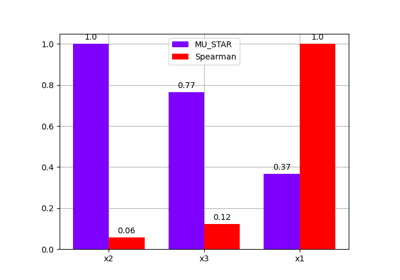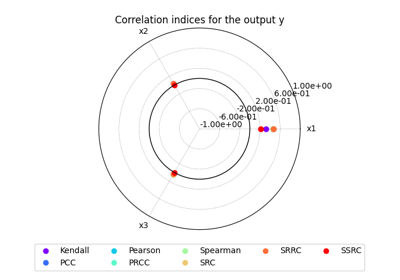analysis module¶
Class for the estimation of various correlation coefficients.
- class gemseo.uncertainty.sensitivity.correlation.analysis.CorrelationAnalysis(disciplines, parameter_space, n_samples, output_names=(), algo='', algo_options=mappingproxy({}), formulation='MDF', **formulation_options)[source]
Bases:
BaseSensitivityAnalysisSensitivity analysis based on indices using correlation measures.
Examples
>>> from numpy import pi >>> from gemseo import create_discipline, create_parameter_space >>> from gemseo.uncertainty.sensitivity.correlation.analysis import ( ... CorrelationAnalysis, ... ) >>> >>> expressions = {"y": "sin(x1)+7*sin(x2)**2+0.1*x3**4*sin(x1)"} >>> discipline = create_discipline( ... "AnalyticDiscipline", expressions=expressions ... ) >>> >>> parameter_space = create_parameter_space() >>> parameter_space.add_random_variable( ... "x1", "OTUniformDistribution", minimum=-pi, maximum=pi ... ) >>> parameter_space.add_random_variable( ... "x2", "OTUniformDistribution", minimum=-pi, maximum=pi ... ) >>> parameter_space.add_random_variable( ... "x3", "OTUniformDistribution", minimum=-pi, maximum=pi ... ) >>> >>> analysis = CorrelationAnalysis( ... [discipline], parameter_space, n_samples=1000 ... ) >>> indices = analysis.compute_indices()
- Parameters:
disciplines (Collection[MDODiscipline]) – The discipline or disciplines to use for the analysis.
parameter_space (ParameterSpace) – A parameter space.
n_samples (int) – A number of samples. If
None, the number of samples is computed by the algorithm.output_names (Iterable[str]) –
The disciplines’ outputs to be considered for the analysis. If empty, use all the outputs.
By default it is set to ().
algo (str) –
The name of the DOE algorithm. If empty, use the
BaseSensitivityAnalysis.DEFAULT_DRIVER.By default it is set to “”.
algo_options (Mapping[str, DOELibraryOptionType]) –
The options of the DOE algorithm.
By default it is set to {}.
formulation (str) –
The name of the
MDOFormulationto sample the disciplines.By default it is set to “MDF”.
**formulation_options (Any) – The options of the
MDOFormulation.
- class Method(value)[source]
Bases:
StrEnumThe names of the sensitivity methods.
- KENDALL = 'Kendall'
The Kendall rank correlation coefficient.
- PCC = 'PCC'
The partial correlation coefficient.
- PEARSON = 'Pearson'
The Pearson coefficient.
- PRCC = 'PRCC'
The partial rank correlation coefficient.
- SPEARMAN = 'Spearman'
The Spearman coefficient.
- SRC = 'SRC'
The standard regression coefficient.
- SRRC = 'SRRC'
The standard rank regression coefficient.
- SSRC = 'SSRC'
The squared standard regression coefficient.
- compute_indices(outputs=())[source]
Compute the sensitivity indices.
- Parameters:
outputs (str | Sequence[str]) –
The name(s) of the output(s) for which to compute the sensitivity indices. If empty, use the names of the outputs set at instantiation.
By default it is set to ().
- Returns:
The sensitivity indices.
With the following structure:
{ "method_name": { "output_name": [ { "input_name": data_array, } ] } }
- Return type:
- plot(output, inputs=(), title='', save=True, show=False, file_path='', directory_path='', file_name='', file_format='')[source]
Plot the sensitivity indices.
- Parameters:
output (VariableType) – The output for which to display sensitivity indices, either a name or a tuple of the form (name, component). If name, its first component is considered.
inputs (Iterable[str]) –
The uncertain input variables for which to display the sensitivity indices. If empty, display all the uncertain input variables.
By default it is set to ().
title (str) –
The title of the plot, if any.
By default it is set to “”.
save (bool) –
If
True, save the figure.By default it is set to True.
show (bool) –
If
True, show the figure.By default it is set to False.
file_path (str | Path) –
A file path. Either a complete file path, a directory name or a file name. If empty, use a default file name and a default directory. The file extension is inferred from filepath extension, if any.
By default it is set to “”.
directory_path (str | Path) –
The path to the directory where to save the plots.
By default it is set to “”.
file_name (str) –
The name of the file.
By default it is set to “”.
file_format (str) –
A file format, e.g. ‘png’, ‘pdf’, ‘svg’, … Used when
file_pathdoes not have any extension. If empty, use a default file extension.By default it is set to “”.
- Returns:
The plot figure.
- Return type:
- plot_radar(outputs=(), inputs=(), title='', save=True, show=False, file_path='', directory_path='', file_name='', file_format='', min_radius=-1.0, max_radius=1.0, **options)[source]
Plot the sensitivity indices on a radar chart.
This method may consider one or more outputs, as well as all inputs (default behavior) or a subset.
For visualization purposes, it is also possible to change the minimum and maximum radius values.
- Parameters:
outputs (OutputsType) –
The outputs for which to display sensitivity indices, either a name, a list of names, a (name, component) tuple, a list of such tuples or a list mixing such tuples and names. When a name is specified, all its components are considered. If empty, use the default outputs.
By default it is set to ().
inputs (Iterable[str]) –
The uncertain input variables for which to display the sensitivity indices. If empty, display all the uncertain input variables.
By default it is set to ().
title (str) –
The title of the plot, if any.
By default it is set to “”.
save (bool) –
If
True, save the figure.By default it is set to True.
show (bool) –
If
True, show the figure.By default it is set to False.
file_path (str | Path) –
The path of the file to save the figures. If the extension is missing, use
file_extension. If empty, create a file path fromdirectory_path,file_nameandfile_extension.By default it is set to “”.
directory_path (str | Path) –
The path of the directory to save the figures. If empty, use the current working directory.
By default it is set to “”.
file_name (str) –
The name of the file to save the figures. If empty, use a default one generated by the post-processing.
By default it is set to “”.
file_format (str) –
A file extension, e.g. ‘png’, ‘pdf’, ‘svg’, … If empty, use a default file extension.
By default it is set to “”.
min_radius (float) –
The minimal radial value. If
None, from data.By default it is set to -1.0.
max_radius (float) –
The maximal radial value. If
None, from data.By default it is set to 1.0.
**options (bool) – The options to instantiate the
RadarChart.
- Returns:
A radar chart representing the sensitivity indices.
- Return type:
- DEFAULT_DRIVER = 'OT_MONTE_CARLO'
- dataset: IODataset
The dataset containing the discipline evaluations.
- default_output: Iterable[str]
The default outputs of interest.
- property kendall: dict[str, list[dict[str, ndarray]]]
The Kendall rank correlation coefficients.
With the following structure:
{ "output_name": [ { "input_name": data_array, } ] }
- property pcc: dict[str, list[dict[str, ndarray]]]
The Partial Correlation Coefficients.
With the following structure:
{ "output_name": [ { "input_name": data_array, } ] }
- property pearson: dict[str, list[dict[str, ndarray]]]
The Pearson coefficients.
With the following structure:
{ "output_name": [ { "input_name": data_array, } ] }
- property prcc: dict[str, list[dict[str, ndarray]]]
The Partial Rank Correlation Coefficients.
With the following structure:
{ "output_name": [ { "input_name": data_array, } ] }
- property spearman: dict[str, list[dict[str, ndarray]]]
The Spearman coefficients.
ith the following structure:
{ "output_name": [ { "input_name": data_array, } ] }
- property src: dict[str, list[dict[str, ndarray]]]
The Standard Regression Coefficients.
With the following structure:
{ "output_name": [ { "input_name": data_array, } ] }


